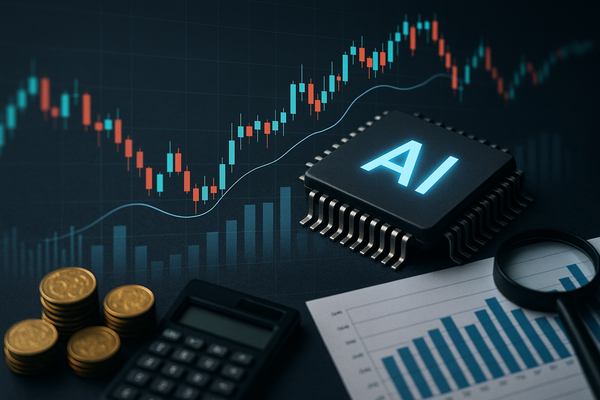
Overview: The market’s current impulse
Technology equities continue to lead headline market moves as investor capital concentrates on artificial‑intelligence compute and the cloud systems that support it. The S&P 500’s strength earlier in 2025 included a 10.94% gain in Q2 (Macquarie Core Equity Fund note), and sector attention is measurable: dataset coverage shows 69 items referencing NVIDIA, 56 for Apple and 42 for Microsoft — a practical proxy for market focus.
Semiconductors: capex winners and valuation dispersion
Semiconductor names are being re‑rated on expected AI hardware demand. NVIDIA’s multiple headlines reflect both momentum and valuation questions: the company’s recent run included intraday moves of roughly 23% in short windows, and analysts have traded between “own” and “reduce” calls as multiples expanded. The ripple was immediate: Intel jumped ~23% on news NVIDIA would invest $5 billion in the company, a trade that recalibrated competitive assumptions.
Broadcom has also benefited; coverage notes the stock has more than doubled over the past year with fresh customer wins cited as potential multi‑billion dollar revenue drivers. AVGO’s rally has pushed investors to compare it with NVIDIA on AI infrastructure exposure.
Smaller, highly‑leverage beneficiaries have shown more volatile moves. Rambus (RMBS) rose 19.0% on AI memory momentum and is up ~173% year‑over‑year per the dataset — an example of how specialized chip and IP plays can reprice quickly. At the ETF level, the semiconductor ETF XSD recovered over 105% from its low, underscoring a broad rotation into chipmakers and equipment suppliers.
Key micro data for investors to track: HBM memory qualifications (Samsung’s HBM3E qualified for NVIDIA while Micron faced HBM4 hurdles; Micron slipped ~3.5%), supplier order flows, and leading foundry utilization. Applied Materials (AMAT) and Lam Research (LRCX) remain direct capex plays — analysts note TEOS 3D and packaging tools gaining share as chipmakers push advanced packaging.
AI cloud and data center demand: hyperscaler commitments
Cloud spending is following AI software demand into large infrastructure commitments. Microsoft announced a $4 billion investment on a second AI data center in Wisconsin and has been tied to at least one $17.4 billion hyperscaler deal referenced in the dataset; OpenAI related spending gossip suggests multibillion to $100 billion commitments for servers over time (market chatter).
Those dollar figures have two effects: direct revenue growth for data‑center suppliers and a structural rise in demand for accelerators, networking, and power systems. Broad beneficiaries include networking and storage suppliers, chip‑equipment vendors and specialist software. Evercore’s $625 price target on Microsoft reflects an expectation of durable AI monetization; Microsoft traded near $518 in a cited clip (+1.88% on that session), showing how investors price the cloud compounder.
Devices and consumer signals: demand still mixed but meaningful
Consumer hardware remains a live barometer for pockets of end‑market strength. Apple’s iPhone 17 rollout produced several datapoints: management reportedly asked assemblers to boost daily output of the standard iPhone 17 by roughly 40%, suggesting stronger than expected demand for the $799 model. At the same time, early reports highlighted outsized interest in Pro models and long retail queues in parts of Europe and Asia.
On valuation and analyst sentiment, Apple’s consensus price target moved only modestly from $236.19 to $240.69 in one update; Bernstein initiated at $290, while JPMorgan action corresponded with a single‑day AAPL bounce of ~3.3% on launch news. Product innovation continues (Apple Watch added FDA‑cleared blood pressure alerts using AI), but rising device prices and tariff pressure have introduced margin and political noise for global distribution.
Software, security and enterprise AI: select names stretching multiples
Enterprise software and cybersecurity remain core growth stories as companies embed AI into workflows. CrowdStrike reported subscription milestones — crossing $1 billion in subscription revenues — and analysts project >20% ARR growth by 2027 in coverage items. That momentum helped CRWD stage recoveries; one headline noted an ~80% rally from prior lows during a rebound phase.
Snowflake and ServiceNow both showed product pushes that underwrite higher consumption: Snowflake’s platform consumption has been a material growth driver and ServiceNow launched the Zurich platform focused on autonomous workflows and multi‑agent AI tools. Intuit reaffirmed FY26 guidance with double‑digit growth targets, illustrating that mature SaaS franchises can still produce steady AI‑driven upside.
Valuation context: not every software name trades at the same premium. IBM’s longer‑term pivot into quantum and enterprise AI is visible in its multiples (IBM cited trading around $253.44 with trailing and forward P/Es of ~40.88 and 21.88), placing it in a different risk/reward bucket than high‑growth pure‑play cloud software firms.
Quantum, niche AI plays and small‑cap risk
Quantum computing and specialist AI plays are receiving more institutional attention. IonQ’s dataset coverage includes government partnerships (U.S. Department of Energy) and analyst speculation about higher targets — Needham and others published upside cases and target ranges such as $80 in a street note. Smaller quantum peers also showed big headline moves: QBTS (D‑Wave) traded near $24.85 in a cited piece, reflecting speculative flows.
These names offer asymmetric upside but carry execution risk, revenue uncertainty, and valuation sensitivity to a small number of contracts. Investors should separate strategic optionality from near‑term cash generation when sizing positions.
What the data implies for portfolio positioning
- Where to look for earnings leverage: semiconductor equipment (AMAT, LRCX), memory/IP suppliers (Rambus, RMBS), and networking (Arista, AVGO exposure) are first‑order beneficiaries of sustained AI capex. Watch order books and HBM qualification cycles.
- Balance growth and valuation: splintered performance means large‑cap cloud names (Microsoft at ~$518 with multi‑trillion market cap positioning) provide defensive AI exposure, while smaller AI infrastructure plays can outperform but with higher volatility (Rambus +19% on a single data point).
- Monitor macro catalysts: Fed guidance and rate moves matter — the dataset references a Fed rate cut that helped extend the market rally. Liquidity will continue to drive appetite for high‑multiple growth names.
- Event risk and politics: tariffs and trade policy (references to U.S. tariffs and Indian market political comments) can create margin pressure for device supply chains and affect regional sales mix for consumer tech.
Data gaps and watchlist
The dataset provides event‑level detail and selective valuation figures but lacks uniform quarterly revenue and EPS numbers for every company. Investors should monitor upcoming earnings releases for capex beneficiaries, HBM qualification milestones (Micron, Samsung versus NVIDIA customers), and hyperscaler spending updates from Microsoft, Amazon and Google. Also track supplier order books and channel inventories to gauge whether demand is structural or pulled forward.
Bottom line
Capital is flowing to AI compute and cloud infrastructure, producing a two‑speed market: durable, cash‑generative cloud leaders with premium multiples and a cluster of highly re‑rated semiconductor and specialist software names. Key datapoints — NVIDIA/Intel partnership ($5 billion), Intel’s ~23% intraday jump, Apple’s ~40% iPhone 17 standard production increase request, Rambus’s 19% surge and XSD’s >105% recovery from lows — illustrate concentration of returns. For active investors and market participants, the immediate task is to differentiate vendors of long‑cycle AI capex from one‑off beneficiaries and size exposure according to revenue visibility and balance‑sheet resilience.
Author’s note: dataset coverage is heavily weighted to September 2025 headlines. Readers should combine these signals with company earnings reports and order‑book disclosures before making material portfolio changes.












